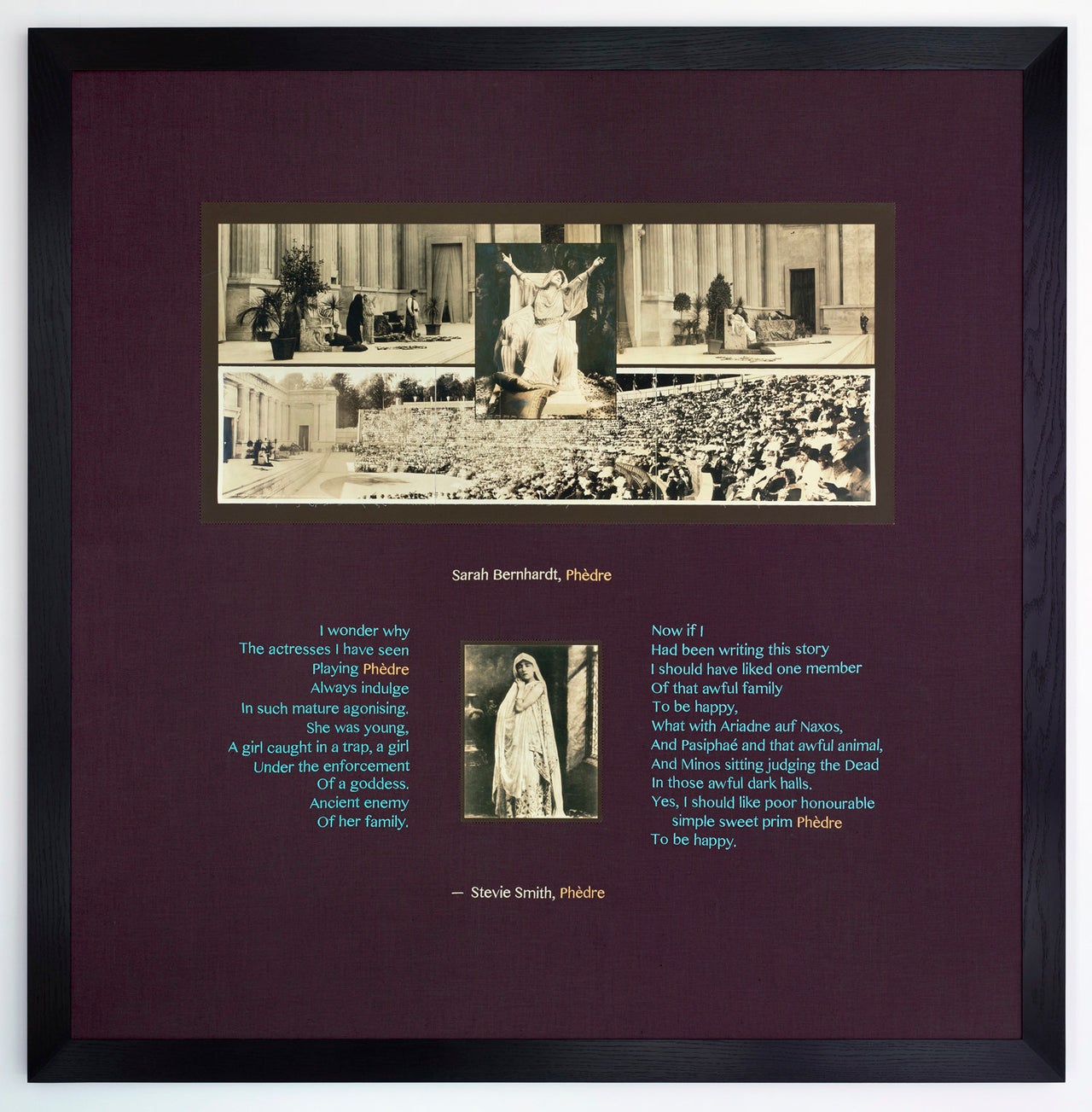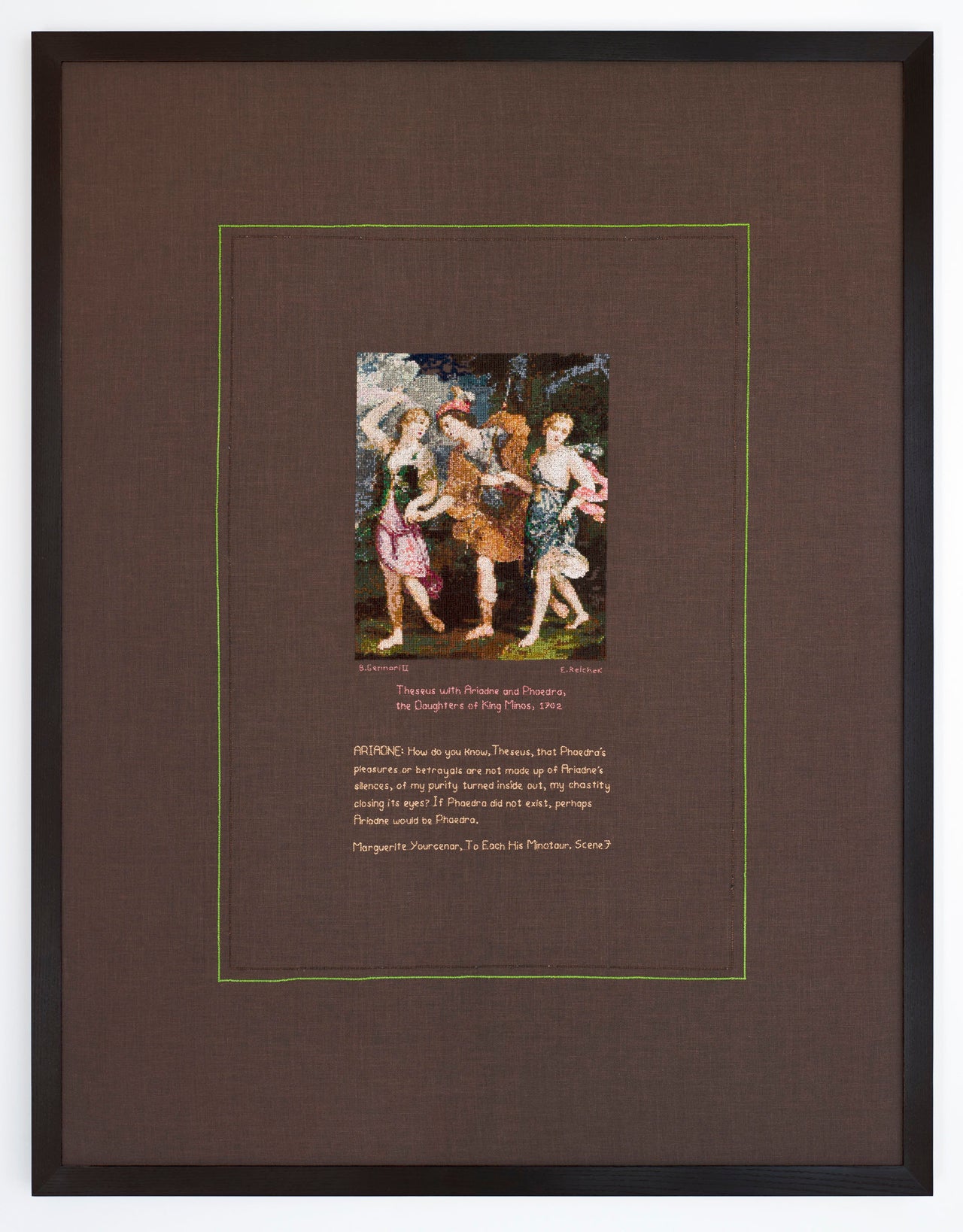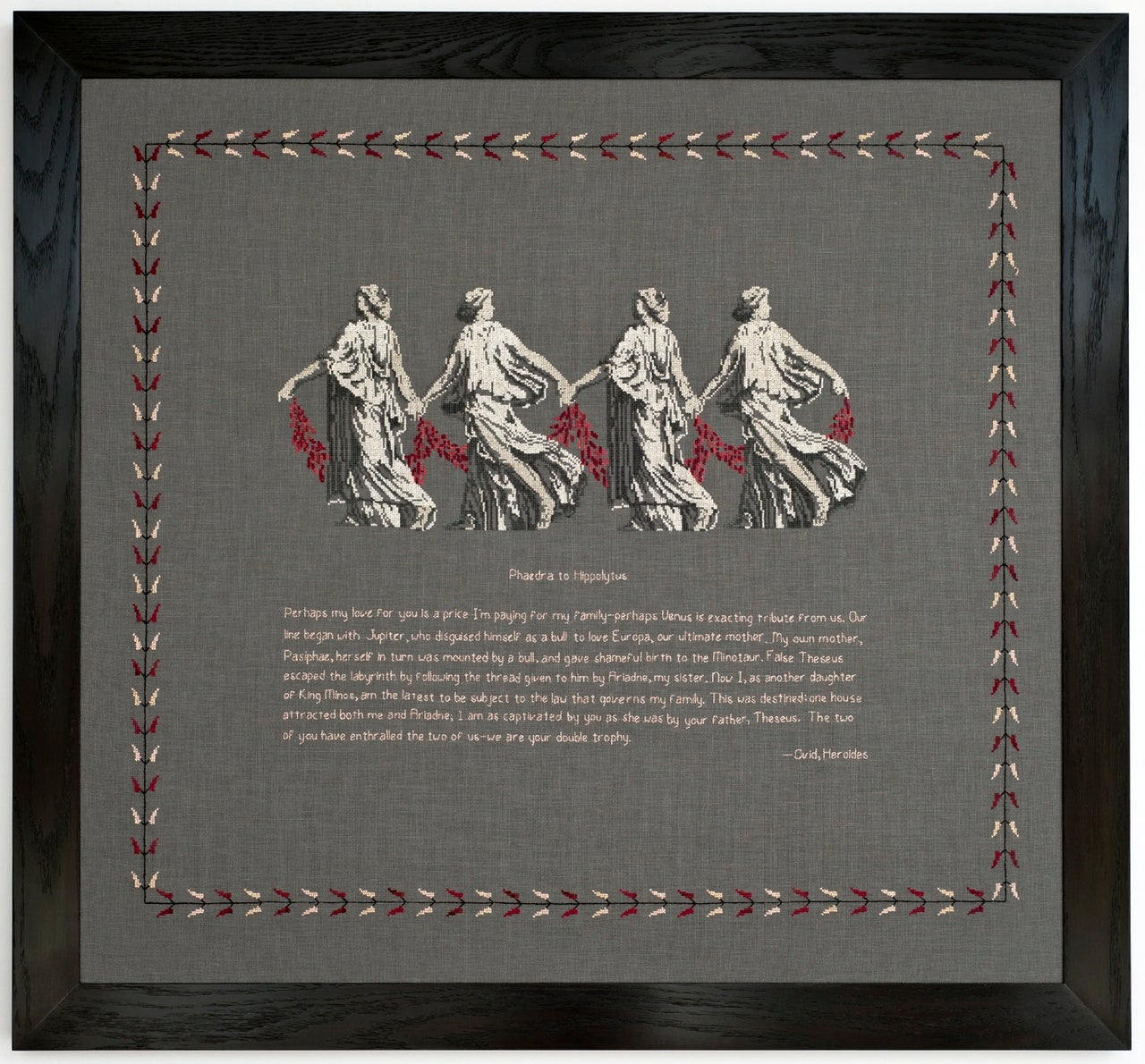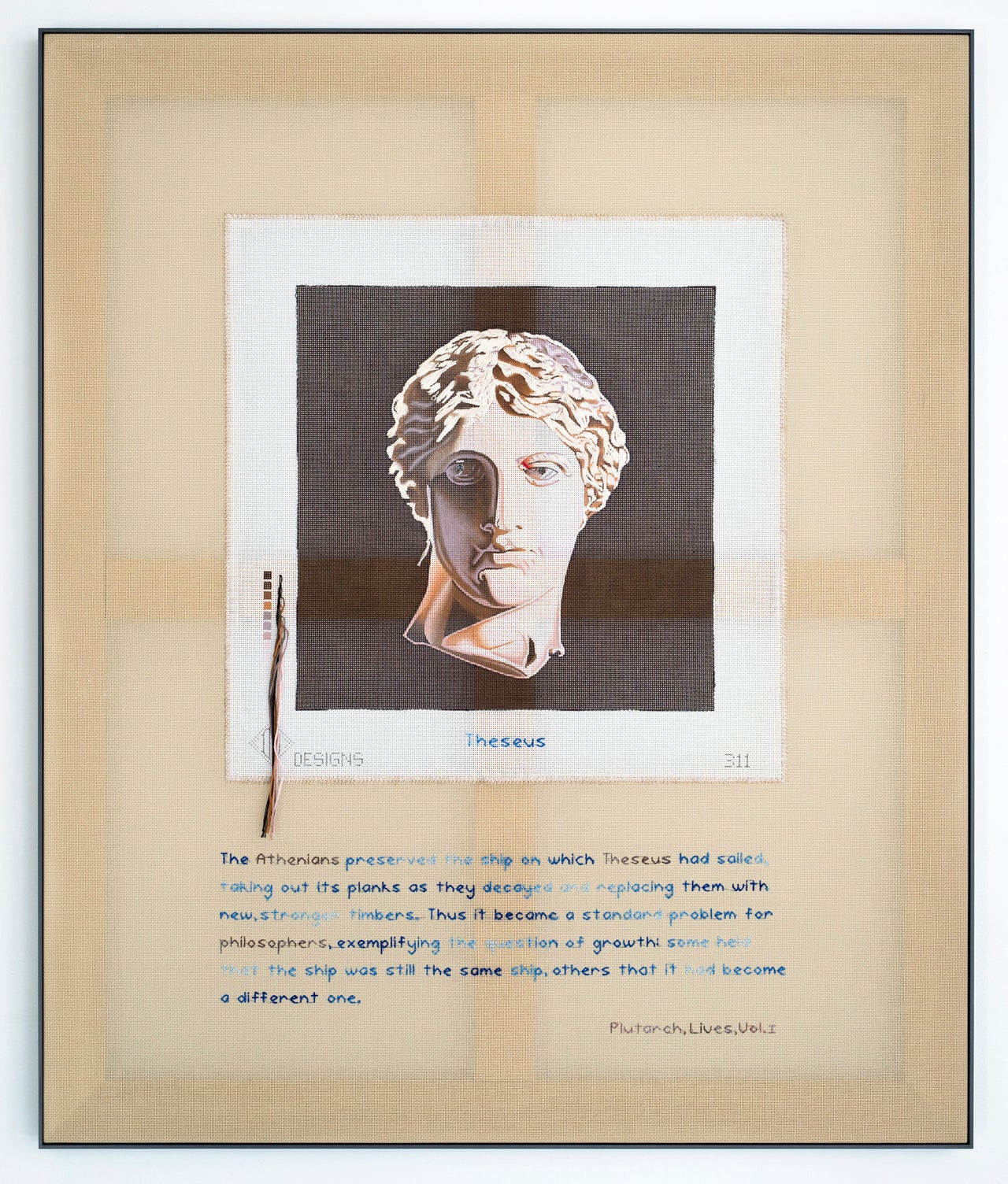"I’ve always been interested in stories," artist Elaine Reichek explained to The Huffington Post. "And myths are fabulous stories, especially in how they serve as metaphors for a variety of human behaviors."
In her latest project "Minoan Girls," Reichek brings the ancient Greek characters Europa, Pasiphae, Phaedra and Ariadne to life through intricately hand-sewn embroideries.
"They’re all very bad," Reicheck laughed when expressing what drew her to the characters. "Lust, incest, bestiality, betrayal, passion, dread. They’re all women of great passion, great energy and great bravery."

The show is a continuation of Reichek's previous exhibition, "Ariadne's Thread," which focused on the latter mentioned Minoan girl, whom the artist describes as "a woman of action." The clever character is known for giving warrior Theseus a ball of thread to help him navigate his way out of a labyrinth. The two run off together, but ultimately Theseus abandons Ariadne one night as she's sleeping. Although Ariadne is often portrayed as a victim in the scenario, myth tells us that she experiences a change of heart too, eventually finding her way to a god -- Bacchus.
"It’s a story of thread," the artist said. Fittingly, thread is at the heart of Reichek's practice, too. "My work is interested in thread -- interns of thread as narrative, thread as family tree, thread as basic element."
Although she's been working with thread since the 1970s, Reichek formally trained as a painter. She studied at Yale under abstract painter Ad Reinhardt, at a time when there were no women on the faculty. Post-graduation, the art world was bent on rewriting history, doing away with art that looked too much like, well, art.

In the search for a mark-making medium that was decidedly un-art-like, Reichek stumbled upon thread. Considered a traditionally feminine craft material, Reichek was far more interested in thread's formal qualities than its gendered associations. "As a line it could pierce the support beneath it and come out the other end. It was an embodied line, something palpable, that sat on the surface and yet was attached to it."
At first, Reichek understood her technique as drawing with thread, not sewing. "It was only later, after I had my first show, that I realized I was embroidering and it terrified me. And because it terrified me, I just went for it."
In the early years, the art world's response was riddled with misogyny. "What I was doing was women’s work, it was not taken seriously," she recalled. "People called it a career killer. For a woman to use thread and embroidery -- it was seen as a hobby."

Yet over time, art world hierarchies destabilized. Feminist art initiatives like Woman House and galleries like A.I.R. shattered the notion that artistic genius was a status attributed only to white men. No longer is serious art associated with a particular kind of artist, or a particular kind of material. "I used to be lonely," Reichek mused, "now I have all these new friends!"
To this day, most of Reichek's works are made by hand; she refers to herself as a "studio dinosaur." She starts by hunting for images, "google shopping" or scanning books, cataloging them on a computer. She then runs her composite images through a program that translates every pixel into a specific color, a potential stitch just waiting to come into being. Using this chart as a guide, Reichek embroiders her final image by hand. Occasionally, Reichek will use a digital sewing machine to create her works, which show up, unlike the handmade ones, completely flat. But for the most part, Reichek prefers to do things the old fashioned way.

"I’ve always been interested in old technologies," she said. She briefly explained the history of the Jacquard-loom, the 19th century mechanical loom that served as the model for early computers. "Textiles have always been at the root of computer technology," Reichek explained.
Indeed, mathematician Ada Lovelace, known for her work with Charles Babbage on an early mechanical, general purpose computer, summed up the connection between a sewing machine and a computer, recognizing the latter's ability to translate symbols as opposed to just process numbers. As Lovelace famously said: "We may say most aptly that the Analytical Engine weaves algebraic patterns just as the Jacquard-loom weaves flowers and leaves."
The correlation, as Reichek describes it, between "pixel and stitch," remains at the core of her practice. "Even photoshop is based on the color wheel," she adds. "Text and textile. Etymologically they’ve always been tied."

There are countless additional parallels between text and embroidery. Both are densely layered, composed of many overlapping threads and just as many potential meanings. "When you work with old texts there are so many interpretations," Reichek said. "People will read it differently, see it differently, hear it differently. Things that are porous and open and allow for multiple interpretations are the ones that survive and feel relevant, we can inject ourselves into them."
Although she's an avid reader, Reichek's first love has always been the image. In our modern day, image-saturated culture, she's quite at home, as visuals both virtual and physical are constantly veering into our lines of sight. However, as much of Reichek's work explores mass culture's obsession with image, it's no new phenomenon.

"Minoan Girls" features two embroidered versions of "The Rape of Europa," iconic paintings based on Greek mythology. In the ancient tale, Zeus became enamored of Europa's beauty and resolved to seduce her. To do so, he transformed himself into a white bull and, when Europa sat on his back, absconded to the island of Crete with Europa attached. He then revealed himself and crowned Europa the Queen of Crete.
The vision of Europa bolting into the sea atop a white bull has been immortalized throughout art history, notably by Titian and Peter Paul Rubens. "The great Rubens copied the great Titian!" Reichek said, noting how issues of copying, appropriation, and image saturation have existed long before the Internet. "Now it’s called appreciation but then, that was how it was done. Everybody has always wanted visual information all the time because it’s so intriguing. Now we live in such an image saturated culture, but it was always acceptable."
"Multiple versions of the same pictures, this one copying from that one," she concluded. "All of this, from the beginning."

